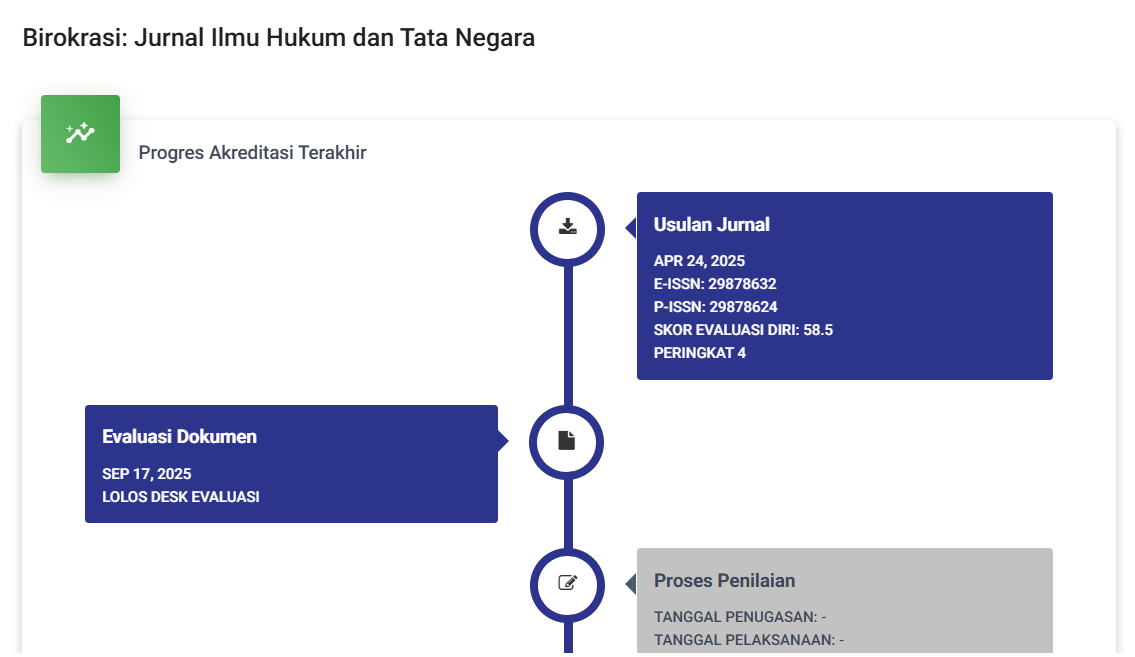Strategi Penerapan Reformasi Birokrasi Pada Sekretariat Jenderal Kementerian Koperasi Dan Usaha Kecil Menengah Republik Indonesia
DOI:
https://doi.org/10.55606/birokrasi.v2i3.1338Keywords:
Strategy, Bureaucratic Reform, SecretariatAbstract
The implementation of bureaucratic reform at the Secretariat General of the Ministry of Cooperatives and SMEs of the Republic of Indonesia is still seen as an additional task and has not become an integrated part of the strategy to increase efficiency and effectiveness in realizing agency performance, then the organizational and governance restructuring carried out still requires adjustments to tasks and functions in achieving output as expected, then another problem is the still limited professionalism of the apparatus, especially in terms of competence and commitment in implementing bureaucratic reforms. This study aims to identify and analyze the strategy for implementing bureaucratic reform in government institutions, the Office of the Ministry of Cooperatives and SMEs of the Republic of Indonesia, especially the Secretariat General based on Geoff Mulgan's theory, of purpose, environment, direction, action, learning. The method used is descriptive with a qualitative approach. Data collection techniques through interviews, observation, and documentation. The results of the study show that the objective indicators are optimal, namely the leaders of the bureaucratic reform team and employees are trying to increase the value of bureaucratic reform indicators with various activity programs. Environmental indicators are not optimal, due to the lack of human resources in abilities, knowledge, attitudes. The direction indicator is optimal, because employees get guidance and direction from the leader in terms of coordination, communication and motivation. The action indicators have not been optimal, because they are still faced by unresolved obstacles such as the transfer of positions between units and policy changes. In learning indicators that are not optimal, in the performance targets of each individual and organizational performance, the results are still lacking and there are still supervisors who do not reflect the feasibility and appropriateness so that they must be retested in order to realize good practice.
References
Buku
David, F. R. (2011). Strategic Management: Manajemen Strategi Konsep (12th ed.). Jakarta: Salemba Empat.
David, F. R., & David, F. R. (2015). Strategic Management: A Competitive Advantage Approach, Concepts, and Cases (15th ed.). New Jersey: Pearson Education.
Djumara, N. (2008). Modul 4 Pengembangan Budaya Kerja Aparatur, Diklat Teknis Manajemen Sumber Daya Manusia Pegawai Negeri Sipil (Human Resource Management). Departemen Dalam Negeri dan Lembaga Administrasi Negara.
Dokumen Rencana Strategis Sekretariat Kementerian Koperasi dan UKM Tahun 2020-2024, hal 14-16. Diakses pada November, 2022.
Dokumen Rencana Strategis Sekretariat Kementerian Koperasi dan UKM Tahun 2020-2024, hal 34. Diakses pada November, 2022.
Dwiyanto, A., dkk. (2012). Reformasi Birokrasi Publik di Indonesia. Yogyakarta: Gadjah Mada University Press.
Hayat, et al. (2018). Reformasi Kebijakan Publik: Prespektif Makro dan Mikro. Jakarta: Prenamedia Group (Divisi Kencana).
Johnson, G., & Scholes, K. (2016). Exploring Corporate Strategy (8th ed.). Boston: Prentice Hall.
Kaplan, R. S., & Norton, D. P. (2004). Strategy Map: A Strategic Management System, Converting Intangible Asset Into Tangible Asset. USA: Harvard Business School Press.
Komarudin. (2011). Reformasi birokrasi dan pelayanan publik. Jurnal Sekretariat Negara, (20), 145-190.
Komarudin. (2014). Reformasi Humas Pemerintah. Bandung: Genesindo.
Kuncoro, M. (2005). Strategi: Bagaimana Meraih Keunggulan Kompetitif. Jakarta: Erlangga.
Miles, M. (2009). Analisis Data Kualitatif. Jakarta: UI-Press.
Moleong, L. J. (2007). Metode Penelitian Kualitatif. Bandung: Remaja Rosdakarya.
Prahalad, C. K., & Hamel, G. (1995). Strategic Management. New Delhi: Tata McGraw Hill.
Rangkuti, F. (2005). Analisis SWOT Teknik Membedah Kasus Bisnis. Jakarta: PT Gramedia Pustaka.
Scott, D. M. (2013). The New Rules of Marketing & PR: How to Use Social Media, Online Video, Mobile Applications, Blogs, News Releases, & Viral Marketing to Reach Buyers Directly. New Jersey: John Wiley & Sons, Inc.
Sedarmayanti. (2013). Manajemen Sumber Daya Manusia: Reformasi Birokrasi dan Manajemen Pegawai Negeri Sipil. Bandung: PT Refika Aditama.
Sugiyono. (2019). Metode Penelitian Kuantitatif, Kualitatif, dan R&D. Bandung: Alfabeta.
Supriana, T. (2018). Strategi Pembangunan dan Kemiskinan. Jakarta: Rineka Cipta.
Jurnal
Arifin, N. (2015). Strategi pemasaran dan minat beli. Jurnal Simbolka, 3(1). ISSN 2442-9198.
Dikson, J., Sahi, A. N., Fachri, M., Wahab, A., & Nuna, M. (2022). Analisis reformasi birokrasi dalam meningkatkan kompetensi sumber daya manusia aparatur sipil negara di Kecamatan Buntulia Kabupaten Pohuwato. Jurnal Economics and Digital Business Review, 3(2), 355-368. ISSN 2774-2563.
Kalbamany, N. R. P. (2022). Efektivitas reformasi birokrasi dalam meningkatkan kinerja organisasi di Badan Kesatuan Bangsa dan Politik Kota Tual, Provinsi Maluku. Institut dalam Negeri.
Lestari, D. Y. (2018). Pengaruh reformasi birokrasi terhadap kinerja pegawai di Dinas Kependudukan dan Pencatatan Sipil Kabupaten Situbondo. Jurnal OJS Unars, 14(1), Mei 2018. ISSN 0215-0832.
Panotogomo, P. U. (2018). Strategi pelaksanaan reformasi dan birokrasi dalam pelayanan publik di Kantor Imigrasi Kelas I Malang. Repository Universitas Brawijaya.
Permana, K. B. (2019). Reformasi birokrasi dalam meningkatkan kinerja aparatur pada Dinas Koperasi, UMKM, Perdagangan dan Perindustrian Kabupaten Pesisir Selatan Provinsi Sumatera Barat. Jurnal MSDA, 7(1), 41-62, Juni 2019.
Tania, C. (2018). Implementasi strategi Dinas Pariwisata Kabupaten Tapanuli Tengah dalam pengembangan daerah wisata pantai di Kecamatan Pandan. Skripsi, Universitas Sumatera Utara.
Perundang-undangan
Peraturan Presiden Nomor 96 tahun 2020 tentang Kementerian Koperasi dan UKM (25 September 2020)
Peraturan Presiden Nomor 81 Tahun 2010 tentang Grand Design Reformasi Birokrasi 2010-2025.
Peraturan Menteri Pendayagunaan Aparatur Negara dan Reformasi Birokrasi Nomor 25 Tahun 2020 tentang roadmap reformasi Birokrasi 2021-2024.
Surat Keputusan Menteri Koperasi dan usaha kecil menengah Republik Indonesia. Nomor 32 Tahun 2021 tentang road map reformasi birokrasi Kementerian Koperasi usaha kecil dan menengah Tahun 2021-2024.
Peraturan Menteri Pandayagunaan Aparatur Negara dan Reformasi Birokrasi Nomor 11 Tahun 2015 tentang sasaran reformasi birokrasi.
Sumber Internet
Google. (n.d.). Retrieved from https://www.google.co.id
Kementerian Koperasi & UKM (2021).svg. Retrieved from https://id.m.wikipedia.org/wiki/Berkas:Logo_Kementerian_Koperasi_%26_UKM_%282021%29.svg
Kementerian Koperasi dan UKM. (n.d.). Retrieved from https://kemenkopukm.go.id/
Kementerian Koperasi dan UKM. (n.d.). Struktur organisasi. Retrieved from https://kemenkopukm.go.id/struktur-organisasi/?I4923ndZtlS1Wojs43AYkn8Q7SxjTGNLEYyDPshWTzHzO8EVJ1
Wikipedia. (n.d.). Berkas








